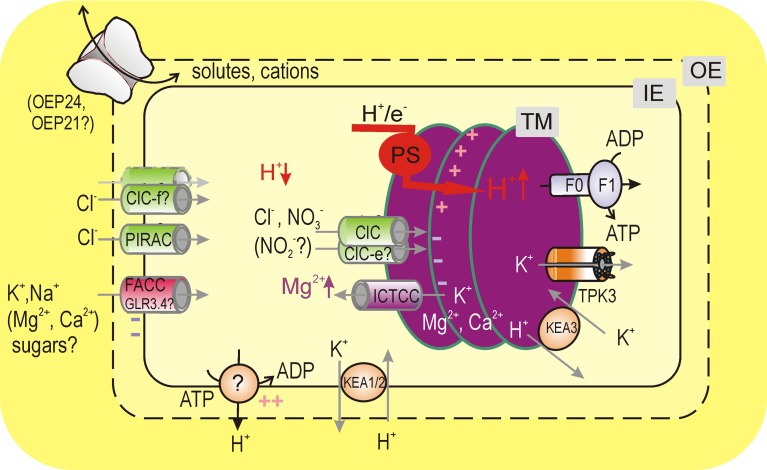Figure 1.
Chloroplast ion transport under the light. Light-driven export of H+ into the thylakoid lumen by photosynthetic electron transfer chain (PS) causes a hyperpolarization of the thylakoid ΔΨ. At steady state, this voltage difference is partly dissipated by channel-mediated fluxes of anions, K+, and Mg2+. Light-driven H+ and parallel Cl− fluxes to the thylakoid lumen cause the depletion of these ions in stroma, which is compensated by their uptake across the envelope. For maintenance of alkaline stromal pH, H+ could be actively extruded to cytosol by the IE H+ pump, which requires a counter influx of monovalent cations across the envelope for electrical balance. K+/H+ exchange across the envelope is essential for control of the chloroplast volume and stromal pH. Abbreviations: TM, IE, and OE are thylakoid, inner envelope, and outer envelope membranes, F0F1 is thylakoid ATP-synthetase (F-type H+-ATPAse), TPK3 (tandem-pore K+ 3 channel, functionally characterized in recombinant system). In situ functionally (by patch-clamp) detected channels were: ClC (anion-selective channel from a ClC family), ICTCC (intermediate-conductance thylakoid cation channel), FACC (fast activating chloroplast cation channel), PIRAC (protein import related anion channel), and outer envelope porins (most possibly, active OEP24 or OEP21). Other: GLR3.4 (glutamate receptor type 3.4 channel) and KEA1/2 (cation/proton antiporters from family 2, CPA2). Another member of the CPA2 family, the thylakoid-localized KEA3, accelerates dissipation of the transthylakoid ΔpH upon the light offset.

